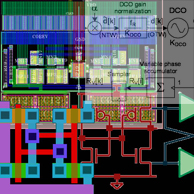|

|
This
research laboratory was established to investigate various aspects
of VLSI circuits and systems design. Specifically we are interested
in design of energy efficient digital circuits and systems, circuits
for nano-CMOS and beyond, VLSI architectures and algorithms for
signal processing and communications, and
power electronics. Current research activity include:
-
Circuits and Systems for Signal
Processing and Communications:
This activity involves developing VLSI
algorithms, architectures and circuits for digital signal
processing, and wireless communications. This research
leverages their background in energy efficient, digitally
intensive mixed-signal design techniques to develop circuits and
systems for these applications suitable for implementation in
nano-CMOS technologies. Projects include, All-digital PLL
(ADPLL), envelope tracking for efficient power amplifiers, etc.
-
Energy Efficient Digital Systems and
Power Electronics:
This is an ongoing investigation in which
techniques are being developed for lowering power dissipation in
digital systems without drastically affecting performance. With
the ever growing popularity of battery powered portable
applications like personal communication systems, mobile
computing, etc., energy efficient, high performance circuits are
gaining importance. Investigation is also being carried for
developing efficient control algorithms and digital controllers
for different topologies of power converters.
-
Circuits using NEM Relays: This investigation involves the use of
nano-electromechanical (NEM) relays in conjunction with CMOS
technology to design novel digital and mixed-signal circuits.
Work is under way to design innovative digital and power
management circuits by exploiting interesting switching
characteristics of these NEM relays.
The VLSI
Design Lab projects have been sponsored or supported by the
following organizations:
Texas Instruments, Semiconductor Research Corporation, US
National Institute of
Justice, and UTD Erik Jonsson School of Engineering and
Computer Science.
|
|